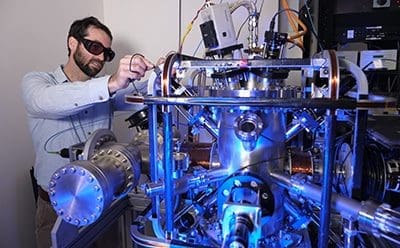Red Meat 2030 has set some ambitious targets for the industry and none so apparent as to double the value of sales of Australian red meat.
With 80,000 businesses engaged in the red meat supply chain from conception to consumption, it is a dynamic and complex operating environment dealing with short-term issues and long-term strategic priorities.

University of Adelaide researcher Dr Rohan Glover with the Atom Trap Trace Analysis (ATTA) facility at the Institute for Photonics and Advanced Sensing, University of Adelaide
The dilemma is where to best position investment that doubles the value of Australian red meat and ensures a sustainable and productive industry.
Meat & Livestock Australia is next week hosting a ‘great debate’ style breakfast event in Brisbane to explore the topic, and to debate one of the perennial challenge for R&D investment – do we achieve more by investing on-farm or off-farm to ensure the long-term viability of Australia’s beef industry?
The breakfast will take place at Brisbane’s Customs House, 399 Queen Street, next Tuesday 23 November, starting at 6:45am and finishing 9am. A range of industry stakeholders from beef producers (both corporate and private), to processors, lotfeeders, regulators, researchers and industry administrators.
The team representing the ‘on-farm’ investment argument includes:
- Associate Professor Luis Prada e Silva is a leader in the area of ruminant nutrition with QAAFI. Luis’ research interests include linking cattle nutrition with physiological mechanisms and genomic tools.
- Sally Leigo is the program manager for MLA’s adoption program, which aims to put in the hands of producers the latest research, technology and best practices to increase production and profitability of red meat producers. Prior to joining MLA, Sally worked in the NT delivering research and extension projects.
-

Bron Christensen
Bron Christensen is a Theodore beef producer, running a breeding operation with her husband. Bron is currently undertaking a bachelor of science – regenerative agriculture and is the current CEO of the Leucaena Grazing Network.
Opposing them is the ‘post farmgate’ team including:
- David Foote has been in executive management roles across a wide range of agribusiness sectors with significant Australian companies for nearly 40 years. He is currently director, Corporate and Industry Affairs of the Australian Country Choice Group.
 Associate Professor Heather Smyth is a flavour chemist and sensory scientist who has been working with premium food and beverage products for the past 20 years.
Associate Professor Heather Smyth is a flavour chemist and sensory scientist who has been working with premium food and beverage products for the past 20 years.- Darryl Heidke is the Science and Technology program manager with MLA. Darryl manages a portfolio of R&D projects and initiatives with a number of science and technology providers with a focus on developing innovative technologies (including automation) that support processing efficiency and productivity improvements for the red meat value chain.
Moderating the debate, and the audience question and answer session that will follow, will be Beef Central’s Jon Condon.
- Limited seats are still available for the breakfast for industry stakeholders. Click here to register your interest in attending.

Isn’t this question a version of “is it possible to walk and chew gum at the same time?”.
The investments are synergistic ie you get more out of post-farmgate R&D if you have strong on-farm R&D and vice-versa.
So the obvious smart strategy is to do both as well as you can.
Rob
Peter Barnard counselled me on ”this ‘ol chestnut” many years ago.
Post-farm gate investments build consumer demand and underpin innovation and efficiencies in processing and value-adding – these confer benefits to producers.
Pre-farm-gate investment helps drive production efficiencies and technologies, thereby helping increase the quantity and/or quality of supply – these confer benefits to processors.
Any number of economic modelling activities have put robust numbers to these relationships.
Notwithstanding the unprecedented interest consumers now have in the origins, ethics and environmental credentials of food production, I think it’s fair to say that the production and processing (and broader) supply chain sectors are intrinsically linked – investment should be apportioned accordingly.
QED 😁
The agenda and speakers already answer the question.